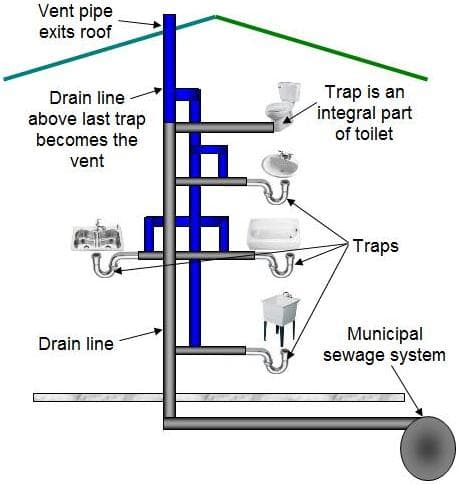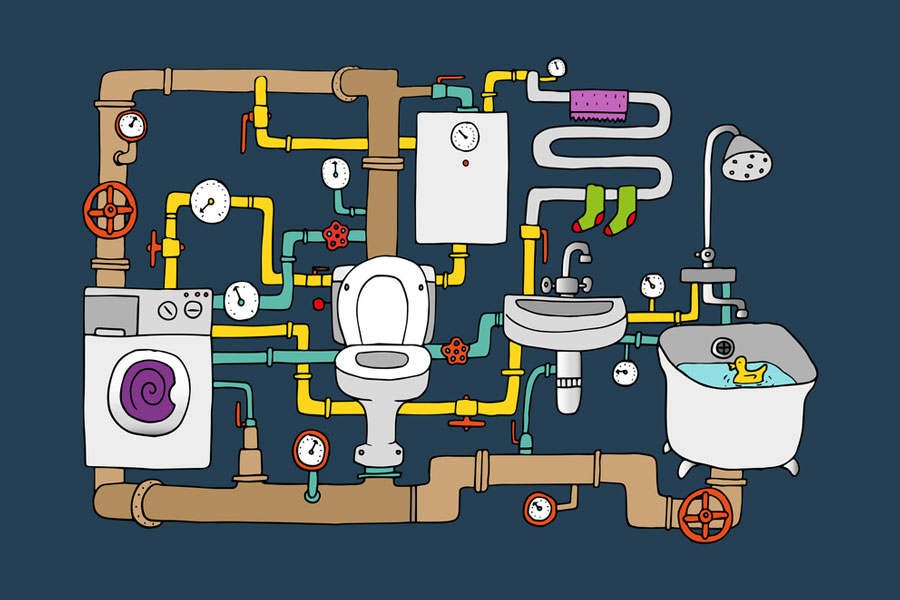We've encountered this post relating to Exploring Your Homes Plumbing Anatomy below on the net and think it made perfect sense to quickly share it with you over here.

Recognizing how your home's plumbing system works is vital for every single homeowner. From delivering clean water for alcohol consumption, cooking, and bathing to securely eliminating wastewater, a well-kept pipes system is important for your family members's health and comfort. In this detailed overview, we'll explore the elaborate network that comprises your home's plumbing and deal pointers on upkeep, upgrades, and dealing with typical concerns.
Intro
Your home's plumbing system is more than just a network of pipelines; it's an intricate system that guarantees you have accessibility to clean water and effective wastewater elimination. Recognizing its parts and just how they work together can help you avoid pricey repairs and guarantee every little thing runs smoothly.
Basic Parts of a Pipes System
Pipes and Tubes
At the heart of your pipes system are the pipelines and tubes that lug water throughout your home. These can be made of different materials such as copper, PVC, or PEX, each with its advantages in terms of toughness and cost-effectiveness.
Fixtures: Sinks, Toilets, Showers, etc.
Fixtures like sinks, toilets, showers, and bathtubs are where water is utilized in your home. Comprehending exactly how these fixtures attach to the pipes system assists in detecting problems and planning upgrades.
Valves and Shut-off Factors
Shutoffs control the circulation of water in your pipes system. Shut-off valves are essential during emergency situations or when you need to make repair services, enabling you to isolate parts of the system without disrupting water circulation to the whole house.
Water System
Key Water Line
The major water line links your home to the metropolitan water supply or a private well. It's where water enters your home and is dispersed to numerous fixtures.
Water Meter and Pressure Regulatory Authority
The water meter actions your water usage, while a stress regulator makes certain that water moves at a safe pressure throughout your home's pipes system, preventing damages to pipes and components.
Cold Water vs. Hot Water Lines
Understanding the distinction in between cold water lines, which supply water straight from the primary, and warm water lines, which lug warmed water from the hot water heater, assists in troubleshooting and preparing for upgrades.
Drainage System
Drain Pipes Pipes and Traps
Drain pipelines carry wastewater far from sinks, showers, and bathrooms to the drain or septic system. Traps avoid sewage system gases from entering your home and also trap particles that could cause obstructions.
Air flow Pipes
Ventilation pipes permit air right into the water drainage system, stopping suction that can reduce drain and create traps to vacant. Appropriate air flow is necessary for preserving the honesty of your plumbing system.
Importance of Proper Drainage
Guaranteeing proper drain protects against back-ups and water damage. Regularly cleansing drains pipes and preserving traps can stop expensive repair work and expand the life of your plumbing system.
Water Heater
Sorts Of Water Heaters
Water heaters can be tankless or standard tank-style. Tankless heating systems heat water as needed, while storage tanks keep heated water for immediate usage.
Updating Your Pipes System
Factors for Upgrading
Upgrading to water-efficient fixtures or replacing old pipes can enhance water high quality, decrease water bills, and increase the value of your home.
Modern Pipes Technologies and Their Benefits
Check out technologies like smart leak detectors, water-saving commodes, and energy-efficient water heaters that can conserve money and lower ecological impact.
Expense Considerations and ROI
Compute the ahead of time costs versus long-lasting savings when thinking about plumbing upgrades. Many upgrades pay for themselves with lowered energy costs and less repair work.
Exactly How Water Heaters Attach to the Pipes System
Understanding how hot water heater connect to both the cold water supply and hot water distribution lines helps in diagnosing issues like insufficient warm water or leakages.
Maintenance Tips for Water Heaters
Frequently flushing your water heater to eliminate sediment, examining the temperature level setups, and checking for leakages can prolong its life expectancy and enhance energy effectiveness.
Typical Plumbing Issues
Leaks and Their Causes
Leakages can happen due to aging pipelines, loosened fittings, or high water pressure. Dealing with leaks promptly stops water damage and mold growth.
Obstructions and Obstructions
Blockages in drains and toilets are typically caused by purging non-flushable items or a build-up of oil and hair. Utilizing drain displays and being mindful of what drops your drains can prevent obstructions.
Indications of Plumbing Troubles to Look For
Low tide pressure, slow-moving drains, foul odors, or abnormally high water expenses are signs of possible plumbing problems that must be dealt with promptly.
Plumbing Maintenance Tips
Normal Assessments and Checks
Arrange yearly plumbing inspections to capture issues early. Seek indications of leakages, corrosion, or mineral build-up in taps and showerheads.
DIY Maintenance Tasks
Simple tasks like cleansing faucet aerators, looking for commode leaks utilizing dye tablet computers, or insulating exposed pipes in cool climates can prevent major pipes concerns.
When to Call a Specialist Plumbing Technician
Know when a pipes concern needs expert expertise. Trying complex repair work without appropriate expertise can cause more damages and greater repair service prices.
Tips for Minimizing Water Usage
Straightforward behaviors like fixing leakages without delay, taking shorter showers, and running complete loads of laundry and recipes can conserve water and lower your energy costs.
Eco-Friendly Plumbing Options
Think about lasting pipes materials like bamboo for floor covering, which is durable and eco-friendly, or recycled glass for kitchen counters.
Emergency Readiness
Steps to Take Throughout a Plumbing Emergency
Know where your shut-off valves lie and exactly how to shut off the water system in case of a burst pipeline or significant leakage.
Importance of Having Emergency Contacts Helpful
Maintain contact information for regional plumbing professionals or emergency situation solutions readily available for quick action throughout a pipes situation.
Ecological Influence and Preservation
Water-Saving Components and Appliances
Setting up low-flow taps, showerheads, and bathrooms can dramatically reduce water use without sacrificing performance.
Do It Yourself Emergency Fixes (When Suitable).
Short-lived solutions like making use of air duct tape to spot a dripping pipe or positioning a pail under a trickling tap can lessen damage until a professional plumbing shows up.
Final thought.
Comprehending the anatomy of your home's plumbing system encourages you to preserve it successfully, saving time and money on repair work. By following regular upkeep regimens and staying informed about modern pipes innovations, you can ensure your plumbing system runs effectively for many years to come.
HOW YOUR PLUMBING SYSTEM WORKS
Which Pipes Do What?
- Blue lines = fresh water supply entering the building
- Red lines = hot water supply entering the building
- Grey lines = pipes carrying waste away from the building and venting pipes carrying gases away from the building (through the roof)
YOUR MAIN PLUMBING SYSTEMS
There are two main plumbing systems that support your home s basic plumbing needs one that brings clean water into your home, and one that sends dirty water away from your home. Connected to the toilet, bath, shower, and other faucets in your home, these two systems keep your water flowing in the right directions.
ACCESSING FRESH WATER
Fresh and clean water is brought into your home through the main water supply line . Filtered through one pipe, this water is pressured to flow into the various fixtures in your home at any given time.
This water can be sourced from a well located on your property, a pond or river (mostly cottages), or, as in most cases, from the city s municipal water treatment centre. However, it is important to note that water that is untreated, such as the water siphoned from ponds or rivers, may not be safe to drink. Personal water supplies always need to be treated for hardness and contaminants before consumed.
MUNICIPAL WATER SUPPLIES
- Improve taste and odour
- Remove sediment
- Eliminate hardness
- Reduce chlorine
COLD WATER SUPPLY VS. HOT WATER SUPPLY
Cold water flows into your home or building through the service line, which then distributes hot or cold water to your fixtures. This line is most commonly run through a central column that runs floor to floor. Hot water runs in short and straight pipes as the longer the pipeline, the more heat that will be lost in the transfer. Having shorter pipes also allows residents to access hot water more quickly.
WASTE WATER SYSTEM
Your wastewater system is divided into two parts pipes that send wastewater away from your home and venting pipes that send sewer gas away from your home. Sewage water travels through pipes that flush the water and waste towards local sewers that are operated and managed by your city or town. Most sewer systems rely on gravity to move the wastewater to where it needs to go.
The further away from your toilet or sink, the larger wastewater pipes become. This allows for waste to be disposed of from various parts of your home or business at once without pipe blockages. The angle and flow of these pipes are also essential for keeping your waste pipes clear of build up.
https://harrisplumbing.ca/how-your-home-plumbing-system-works/

As a keen reader about The Inner Workings of Your Home's Plumbing, I figured sharing that piece of content was sensible. Sharing is caring. Helping others is fun. Kudos for your time. Revisit us soon.
Book Now
Comments on “The Fundamental Elements of Your Property's Plumbing System”